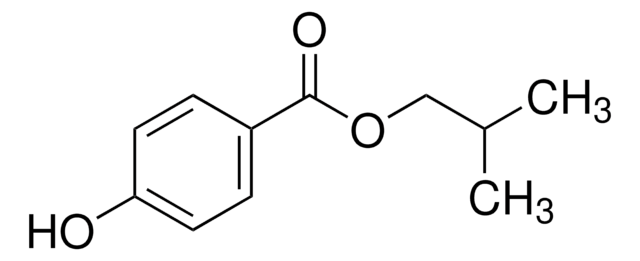H5501
Metile 4-idrossibenzoato
ReagentPlus®, ≥99.0%, crystalline
Sinonimo/i:
4-idrossibenzoato di metile, Metil estere dell’acido p-idrossibenzoico, Metilparaben
About This Item
Prodotti consigliati
Livello qualitativo
Nome Commerciale
ReagentPlus®
Saggio
≥99.0%
Stato
crystalline
Punto di fusione
125-128 °C (lit.)
Stringa SMILE
COC(=O)c1ccc(O)cc1
InChI
1S/C8H8O3/c1-11-8(10)6-2-4-7(9)5-3-6/h2-5,9H,1H3
LXCFILQKKLGQFO-UHFFFAOYSA-N
Cerchi prodotti simili? Visita Guida al confronto tra prodotti
Applicazioni
- in sex-linked recessive lethal (SLRL) test in Drosophila melanogaster
- as a constituent in cream formulation
- as an antifungal agent in Drosophila melanogaster culture
Azioni biochim/fisiol
Note legali
Esclusione di responsabilità
Indicazioni di pericolo
Consigli di prudenza
Classi di pericolo
Aquatic Chronic 2
Codice della classe di stoccaggio
11 - Combustible Solids
Classe di pericolosità dell'acqua (WGK)
WGK 1
Punto d’infiammabilità (°F)
334.4 °F
Punto d’infiammabilità (°C)
168 °C
Dispositivi di protezione individuale
dust mask type N95 (US), Eyeshields, Gloves
Scegli una delle versioni più recenti:
Certificati d'analisi (COA)
Non trovi la versione di tuo interesse?
Se hai bisogno di una versione specifica, puoi cercare il certificato tramite il numero di lotto.
Possiedi già questo prodotto?
I documenti relativi ai prodotti acquistati recentemente sono disponibili nell’Archivio dei documenti.
I clienti hanno visto anche
Il team dei nostri ricercatori vanta grande esperienza in tutte le aree della ricerca quali Life Science, scienza dei materiali, sintesi chimica, cromatografia, discipline analitiche, ecc..
Contatta l'Assistenza Tecnica.




